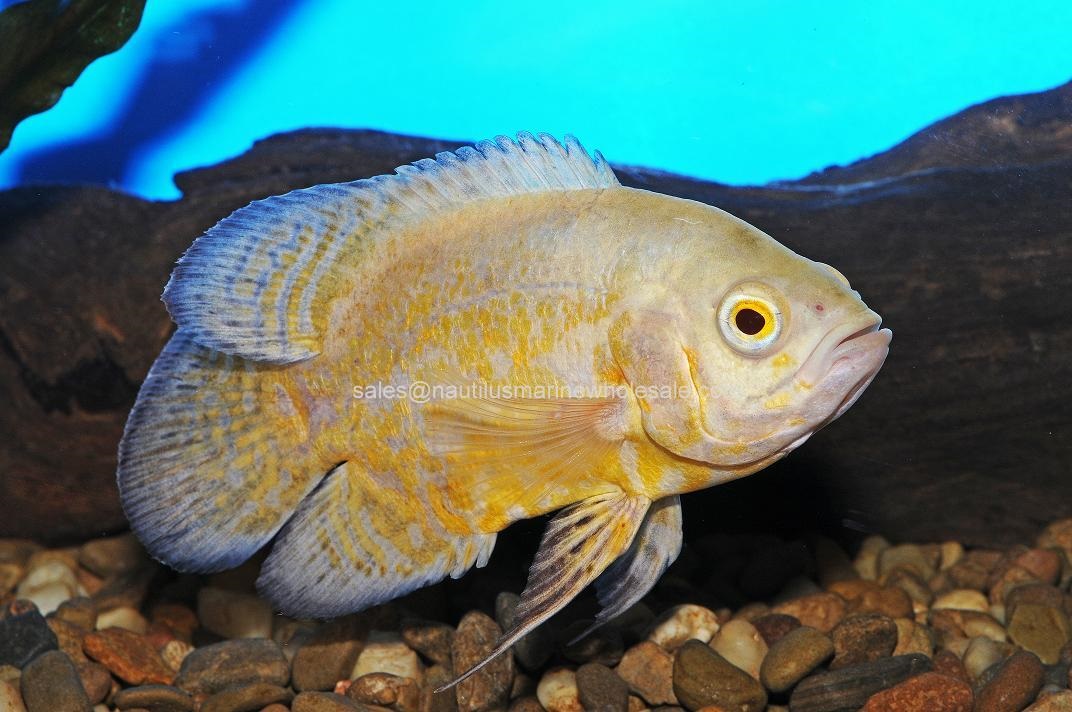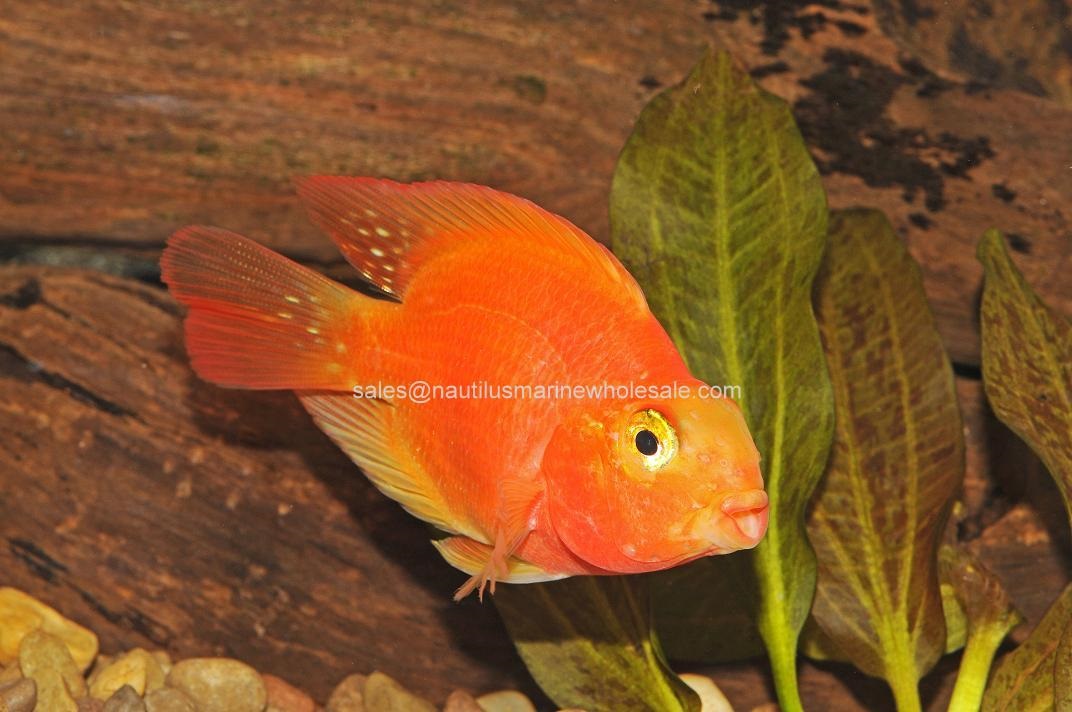
SKU: H744
South American Cichlid Community
In Stock
Out of Stock
Temporarily Out of Stock
Discontinued
Special Order
Price:
Product Details
South American Cichlid Community Aquarium
Why Keep Them? South American cichlids include a number of species that can be found in Central and South America, as well as Mexico and Southern Texas. They range in size, coloration and temperament. When kept in the optimal setup, these fish are hardy and offer a great personality.
Aggression in Cichlids - Many of the Cichlids listed on this page are more aggressive toward their tank mates than most other tropical fish. This aggression is rooted in the natural territorial behavior. In nature many Cichlids defend a territory from other competitors for breeding purposes.
So when you see displays or fighting among these fish they are exhibiting adaptive behaviors that help them survive in the wild.
Housing: Provide a large tank with good filtration. A minimum of a 50 gallon tank is recommeded, but the larger the better. Provide rocks or driftwood. Large Cichlids often uproot live plants, so plastic plants attached to gravel bases are the most popular form of decor. Standard water conditions are acceptable. The addition of some Cichlid salt is advised.
Water Conditions:
Temperature: 74-80 F pH: 7.4-8.5
Foods: Feed Cichlid pellets, sticks or flakes. Supplement with frozen foods like Brine Shrimp, Mysis Shrimp, and Blood Worms.
Compatibility Tips: Maintaining a harmonious tank is the biggest challenge to Cichlid tanks.
Here are some tips:
-Aggressive behavior is rooted in "territoriality''. In nature they defend a territory for breeding purposes.
-They are more likely to fight with fish that have similar shape. Fish that do not resemble the existing fish will be perceived as less threatening For example it may be easier to add a large tinfoil barb, or silver dollar, or gar.
-If you get them small and let them grow they may do better.
-When you add a new fish, feed everyone first. Try re-arranging the aquarium decor to confuse the existing fish. You can also shut off your aquarium lights for a few hours after the addition of a new fish.
-Keep the Cichlids similar sizes.
-Bigger tanks will reduce aggression. 75 gallon and up is best.
-Provide lots of rocks, driftwood, decor for hiding and territory establishment.
-Adult Cichlids can be purchased as singles, juveniles or can be purchased in groups.
Tankmates: The list below list some species you may want to choose for your community. The Cichlids are mostly South American or West African.
Cichlids, Most Aggressive: These fish represent some of the most aggressive fish we sell. Some adults in this group may have to be kept by themselves.: Red Devil, Festae, Managuense, Peacock Bass, Green Terror, Nicaraguense, Jewel Cichlid, Buttikoferi, P. Bleekeri, P. Polleni.
Cichlids, More "Typical" Behavior: Oscar, Jack Dempsey, Firemouth, Salvini, Pike, , Chocolate, Texas, Port, Heckelii, Convict
Cichlids, More "Mild": Blood Parrot, Jurupari, G. Steindachneri, G. Surinamensis, G. Brasiliensis, Severum, Keyhole, Uaru, Kribensis
Catfish: Large Plecostomus, many other large catfish
Others: Anostomus, Leporinus, Spotted Gar, Red Tail Chalceus
Sharks: Large Black Shark, Large Red Tail Shark, Iridescent Shark
Knifefish: Large Knife Fish
Active Fish: Use Dither Fish (fish that occupy the top area of the tank) to mitigate Aggressive Behavior. Add groups of active fish to the tank. Choices can include groups of Giant Danios, Tin Foil Barbs, Silver Dollars, Pink Tail Chalceus, Large Barbs, Large Gouramis, Large Rainbowfish.
Why Keep Them? South American cichlids include a number of species that can be found in Central and South America, as well as Mexico and Southern Texas. They range in size, coloration and temperament. When kept in the optimal setup, these fish are hardy and offer a great personality.
Aggression in Cichlids - Many of the Cichlids listed on this page are more aggressive toward their tank mates than most other tropical fish. This aggression is rooted in the natural territorial behavior. In nature many Cichlids defend a territory from other competitors for breeding purposes.
So when you see displays or fighting among these fish they are exhibiting adaptive behaviors that help them survive in the wild.
Housing: Provide a large tank with good filtration. A minimum of a 50 gallon tank is recommeded, but the larger the better. Provide rocks or driftwood. Large Cichlids often uproot live plants, so plastic plants attached to gravel bases are the most popular form of decor. Standard water conditions are acceptable. The addition of some Cichlid salt is advised.
Water Conditions:
Temperature: 74-80 F pH: 7.4-8.5
Foods: Feed Cichlid pellets, sticks or flakes. Supplement with frozen foods like Brine Shrimp, Mysis Shrimp, and Blood Worms.
Compatibility Tips: Maintaining a harmonious tank is the biggest challenge to Cichlid tanks.
Here are some tips:
-Aggressive behavior is rooted in "territoriality''. In nature they defend a territory for breeding purposes.
-They are more likely to fight with fish that have similar shape. Fish that do not resemble the existing fish will be perceived as less threatening For example it may be easier to add a large tinfoil barb, or silver dollar, or gar.
-If you get them small and let them grow they may do better.
-When you add a new fish, feed everyone first. Try re-arranging the aquarium decor to confuse the existing fish. You can also shut off your aquarium lights for a few hours after the addition of a new fish.
-Keep the Cichlids similar sizes.
-Bigger tanks will reduce aggression. 75 gallon and up is best.
-Provide lots of rocks, driftwood, decor for hiding and territory establishment.
-Adult Cichlids can be purchased as singles, juveniles or can be purchased in groups.
Tankmates: The list below list some species you may want to choose for your community. The Cichlids are mostly South American or West African.
Cichlids, Most Aggressive: These fish represent some of the most aggressive fish we sell. Some adults in this group may have to be kept by themselves.: Red Devil, Festae, Managuense, Peacock Bass, Green Terror, Nicaraguense, Jewel Cichlid, Buttikoferi, P. Bleekeri, P. Polleni.
Cichlids, More "Typical" Behavior: Oscar, Jack Dempsey, Firemouth, Salvini, Pike, , Chocolate, Texas, Port, Heckelii, Convict
Cichlids, More "Mild": Blood Parrot, Jurupari, G. Steindachneri, G. Surinamensis, G. Brasiliensis, Severum, Keyhole, Uaru, Kribensis
Catfish: Large Plecostomus, many other large catfish
Others: Anostomus, Leporinus, Spotted Gar, Red Tail Chalceus
Sharks: Large Black Shark, Large Red Tail Shark, Iridescent Shark
Knifefish: Large Knife Fish
Active Fish: Use Dither Fish (fish that occupy the top area of the tank) to mitigate Aggressive Behavior. Add groups of active fish to the tank. Choices can include groups of Giant Danios, Tin Foil Barbs, Silver Dollars, Pink Tail Chalceus, Large Barbs, Large Gouramis, Large Rainbowfish.
| Product PDF: | |
|---|---|
| Extra Details: |
Related Items:
| Item | Description | Quantity | Price | ||
| 468 |  |
Red Devil Cichlid | in stock | $9.99 | |
| 443 |  |
Nicaraguens Cichlid | in stock | $8.99 | |
| 329 |  |
Buttikoferi Cichlid | out of stock | $14.99 | |
| 454 |  |
Paratilapia Polleni Cichlid | in stock | $106.99 | |
| 377 |  |
Green Terror Cichlid | in stock | $9.99 | |
| 450 |  |
Asst Small Oscar | in stock | $21.99 | |
| 450X |  |
Oscar Cichlid - Med | out of stock | $25.99 | |
| 1704 |  |
Lemon Oscar Cichlid | in stock | $29.99 | |
| 393 |  |
Electric Blue Jack Dempsey | in stock | $21.99 | |
| 392 |  |
Jack Dempsey Cichlid , Small | in stock | $4.99 | |
| 392X |  |
Jack Dempsey Cichlid - Medium | in stock | $35.99 | |
| 363 |  |
Firemouth Cichlid | out of stock | $7.99 | |
| 474 |  |
Salvini Cichlid | out of stock | $4.99 | |
| 459 |  |
Assorted Pike Cichlid | in stock | $24.99 | |
| 336 |  |
Chocolate Cichlid | $9.99 | ||
| 486 |  |
Texas Cichlid | out of stock | $5.99 | |
| 340 |  |
Striped Convict Cichlid | in stock | $3.99 | |
| 318X |  |
Blood Parrot Cichlid - Med | in stock | $25.99 |



